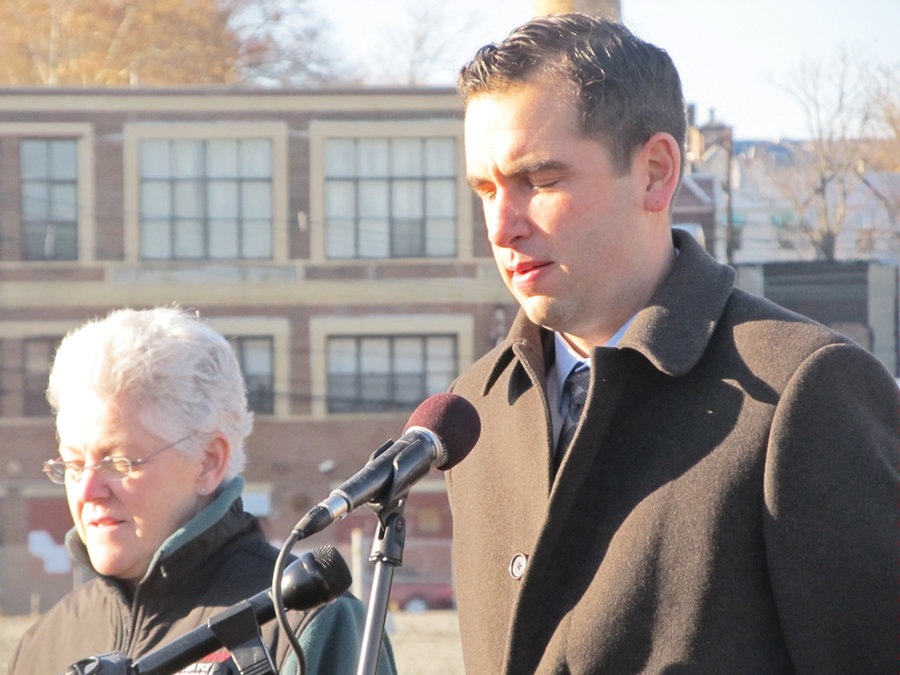Gina McCarthy, administrator for the U.S. Environmental Protection Agency (EPA), made her first trip to Jersey City on Nov. 21 and visited Berry Lane Park, which she cited as an example of successful collaboration between all levels of government.
The EPA has provided federal funds to transform a formerly-industrialized community eyesore into the largest park in the city, with two basketball courts, two tennis courts, a baseball field, a soccer field, and a playground. The property was once home to rail yards, junk yards, auto repair shops, industrial facilities, and warehouses. For years, the site was little more than a canvas for street gang graffiti.
The emerging park is comprised of 11 parcels of land that were assessed and cleaned up with $2.6 million in funding from the EPA’s brownfields program.
“Bringing back activity that increases the value of a community is good for our health and great for local economies, and what makes that possible is working together,” McCarthy said. “By contributing about $2.6 million dollars through our brownfields program, we are proud to support Jersey City in cleaning up and transforming this property into the largest municipally-owned and operated park in the city.”
“This is a tribute to each level of government, local, state and federal working together.” – Mayor Steven Fulop.
____________
A project long in the making
The 17-acre park, located at Garfield and Communipaw avenues, has been on the drawing board for more than 15 years. But the park has been pushed ahead by the Fulop administration, which is seeking funds to finish the work.
The EPA has sent money for the project since 1997, and to date has provided Jersey City with brownfields funding for this and other projects throughout the city. For its part, the city has been cobbling together funding from a variety of sources, including the Hudson County Open Space Trust Fund, to collect the $35 million needed to complete cleanup and construction of the park.
“This is a tribute to each level of government, local, state and federal, working together,” Mayor Steven Fulop said.
Stalled for years, the project picked up steam in 2009, when the city and the state Environmental Protection Agency came to an agreement with Pittsburgh Paint and Glass for the cleanup of contamination on the property that included removing chromium-tainted soil. A chromium plant had operated on Garfield Avenue from about 1924, refining raw chromium ore into paint pigment and other items 24 hours a day.
Pittsburgh Paint and Glass bought the facility in 1954 and ran it until its closing in the fall of 1963. PPG agreed to pay about $5.5 million towards the cleanup costs.
To create the necessary space for the project, 10 of 12 parcels were taken via eminent domain. In Phase One, which cost about $20 million, the city purchased the land, and contracted for the cleanup, grading, and installation of a drainage system as well as the construction of a Little League baseball field.
Phase Two, which is underway, is expected to cost as much as $15 million, and the city still needs to find funding.
The park will begin at the foot of Berry Lane and continue south to the Bergen-Hudson Light Rail System. The former Morris Canal runs along the entire length of the site. The park will reuse the concrete silos at the new Spray Park to create a multifaceted water feature. Active recreation is organized along the path of the historic canal, creating a pedestrian promenade from the neighborhood through the park.
Diane Coleman, council person for Ward F where the park is located, said she is thrilled by the idea of the park.
“I’m very excited about this,” she said.
McCarthy said the park will serve as a reminder to future generations of the benefits of protecting the environment.
“Economic development and environmental protection go hand in hand,” she said. “This is proof when you can turn a contaminated industrial site into an economically vibrant place where people can feel safe to enjoy the outdoors.”
Al Sullivan may be reached at asullivan@hudsonreporter.com.
